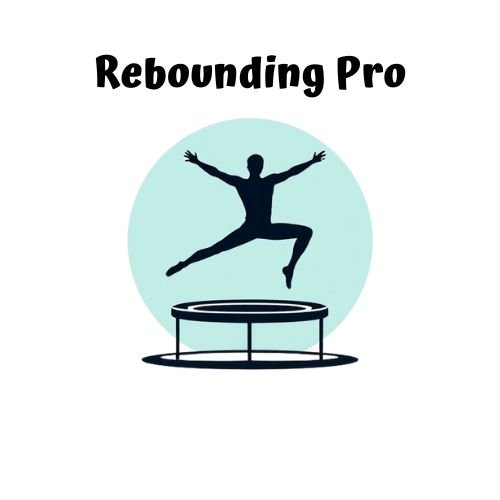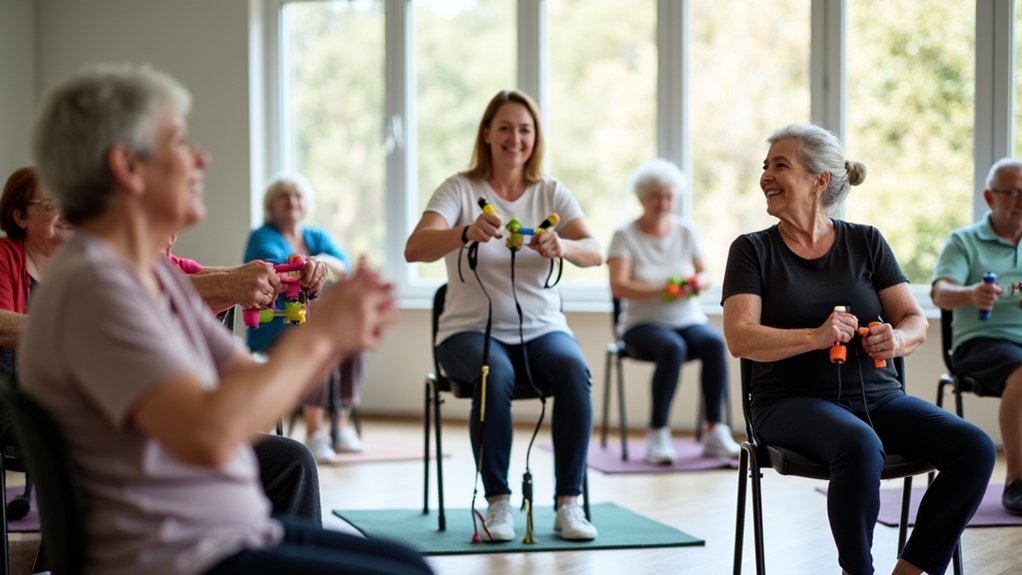While running typically burns more calories initially, rebounding offers greater efficiency for long-term weight management. NASA research shows rebounding is 68% more effective in energy expenditure at similar heart rates, with less joint impact. Your body weight greatly affects results—heavier individuals burn nearly twice as many calories during rebounding. For ideal results, consider combining both exercises to maximize calorie burn while minimizing injury risk. Discover why many fitness experts now recommend this balanced approach.
Calorie Burning Face-Off: Rebounding vs. Running Statistics

Numbers don’t lie when it comes to comparing rebounding and running for calorie burn. A high-intensity rebounding session can torch up to 876 calories while maintaining heart rates around 159 bpm—impressive numbers that often exceed running’s output.
While running certainly burns calories effectively (typically 140-150 bpm for moderate intensity), rebounding shows greater efficiency in oxygen utilization. Your weight considerably impacts results with both exercises—heavier individuals burn more due to increased exertion.
The intensity of your workout dramatically affects outcomes regardless of which you choose. However, rebounding’s gentler impact on joints makes it sustainable for longer sessions, potentially increasing total calorie burn.
Plus, many find bouncing more enjoyable than running, leading to better long-term consistency and cumulative calorie burning benefits. Sydney’s test showed rebounding burned 234 calories compared to running’s 218 calories in the same 30-minute period, demonstrating a slight caloric advantage for trampolining exercises.
The Science Behind Rebounding’s Superior Caloric Efficiency
When scientists examine the metabolic dynamics of exercise, rebounding consistently demonstrates superior caloric efficiency compared to running. NASA research indicates rebounding is 68% more effective in energy expenditure at similar heart rates, while enhancing oxygen intake more effectively than treadmill running.
This efficiency stems from unique biomechanical advantages. The alternating G-forces during rebounding engage multiple muscle groups simultaneously, increasing caloric burn without the joint stress of running. Your body experiences a complete cycle of weightlessness followed by double gravity with each bounce. Our study results confirmed that heavier individuals like Alex, who weighed 208 pounds, burned significantly more calories during identical rebounding workouts compared to lighter participants.
What’s particularly valuable is the prolonged metabolic effect—your body continues burning calories at an elevated rate post-workout. The rhythmic compression and relaxation also stimulates lymphatic circulation, potentially enhancing your body’s natural detoxification processes and further contributing to rebounding’s metabolic advantages.
Comparing Heart Rate Zones: Impact on Calorie Burn

Your heart rate zone greatly impacts both the amount and type of calories you’ll burn during exercise, with rebounding and running affecting these zones differently.
While running typically pushes you into higher heart rate zones for greater overall calorie burn, rebounding can maintain you in fat-burning zones longer without excessive strain.
You’ll maximize your efficiency by choosing the exercise that helps you sustain your target heart rate zone based on whether your goal is fat loss or overall caloric expenditure.
For optimal fat burning, aim to keep your heart rate between 60% to 70% of your maximum, where approximately 65% of calories burned come from fat stores rather than carbohydrates.
Heart Rate Zone Differences
Although both exercises get your heart pumping, running and rebounding create distinctly different heart rate patterns that directly impact calorie expenditure.
When you’re running at a moderate pace, your heart rate typically climbs higher—often reaching 150-170 bpm—compared to rebounding’s more modest 120-130 bpm range.
This difference matters considerably for calorie burning. Running’s ability to push your cardiovascular system into higher zones explains why it burns 600-800 calories hourly at moderate intensities, while rebounding typically maxes out at 250-400 calories per hour. This difference in caloric expenditure aligns with the evidence that traditional cardio options tend to burn more calories overall.
Even during high-intensity intervals, rebounding rarely matches running’s cardiovascular demand.
The trade-off? Your joints face substantially less impact stress on a rebounder, making it an excellent option if you’re managing injuries or need lower-impact alternatives.
Maximum Efficiency Training
Despite burning fewer total calories than running, rebounding can still deliver efficient results when you train in the right heart rate zones. Your calorie burn efficiency depends on maintaining your heart rate at 70-85% of your maximum for ideal fat burning.
When rebounding, you’ll need to increase intensity through faster bouncing or adding arm movements to reach these zones. Running naturally pushes you into higher heart rate zones, especially during hill work or sprints. HIIT workouts can be incorporated into both rebounding and running routines to significantly increase calorie expenditure in shorter timeframes.
To maximize calorie burn with either activity, incorporate interval training. Alternate between high-intensity bursts and recovery periods to trigger EPOC (Excess Post-Exercise Oxygen Consumption), which keeps your metabolism elevated for hours afterward.
The key isn’t just which activity you choose, but how you structure your workout to maintain appropriate intensity.
Sustained Elevation Advantages
The prolonged effects of heart rate elevation offer distinct advantages for both rebounding and running workouts. You’ll experience sustained calorie burn when your heart rate remains elevated in the ideal zone, whether you’re bouncing or pounding the pavement.
| Workout Type | Heart Rate Range | Calorie Burn (30 min) | Joint Impact |
|---|---|---|---|
| Rebounding (Low) | 127 bpm | 150-180 calories | Very Low |
| Rebounding (High) | 159 bpm | 200-234 calories | Low |
| Running (Moderate) | 140 bpm | 180-200 calories | Moderate |
| Running (Intense) | 160+ bpm | 218+ calories | High |
Rebounding provides these benefits with considerably less joint stress, allowing for longer workouts and potentially greater oxygen intake. According to extensive research, rebounding can be up to 68% more effective than jogging at similar intensity levels. While running offers similar heart rate elevation, rebounding’s adaptability makes it accessible across fitness levels—maintaining that essential elevated zone without overtaxing your body.
NASA’s Research on Rebounding vs. Traditional Cardio

When NASA conducted groundbreaking research comparing rebounding to running, they discovered something remarkable: 10 minutes on a trampoline burns more calories than 30 minutes of running. Their study with eight young men found rebounding to be 68% more effective than jogging for calorie burn.
Using a competition-style trampoline, researchers measured body acceleration, oxygen uptake, and heart rate responses. They found rebounding effectively counteracts the deconditioning seen in astronauts due to zero gravity environments. Your body experiences beneficial gravitational stress during rebounding that stimulates bone mineral retention and muscle preservation. This finding explains why rebounding is increasingly used in physical therapy settings to help patients recover.
What’s more surprising? Participants rated rebounding as 10% less strenuous than anticipated, despite its higher caloric burn efficiency. This makes rebounding an accessible option for various fitness levels while delivering superior cardiovascular benefits compared to traditional cardio exercises.
How Intensity Levels Affect Calories Burned in Both Exercises
Intensity levels play an essential role in determining how many calories you’ll burn during exercise, whether you’re bouncing on a rebounder or pounding the pavement.
With both activities, higher intensity workouts greatly boost calorie expenditure by maintaining an elevated heart rate. On a rebounder, you can burn up to 876 calories during a vigorous session, while enjoying less perceived exertion than running. Many fitness enthusiasts prefer rebounding because it’s a low-impact exercise that protects joints while still delivering excellent results.
Interestingly, your weight affects calorie burn differently in each exercise – heavier individuals tend to burn more on rebounders due to the increased effort required for each bounce.
Even at lower intensities, rebounding still engages your core muscles effectively, while high-intensity running dramatically increases caloric output.
The duration of your workout matters too – longer sessions with consistent intensity will maximize calories burned regardless of which exercise you choose.
Joint Impact and Energy Expenditure: The Connection
Many fitness enthusiasts overlook the critical relationship between joint impact and calorie-burning efficiency when comparing exercises. When you run, you’ll burn more calories (often considerably more than rebounding’s 250-400 calories per hour), but at a cost—higher joint stress that can lead to injuries like shin splints.
Rebounding, with its MET value of 7.2, offers an efficient calorie-burning alternative that’s gentler on your body. The trampoline absorbs up to 80% of the impact, allowing you to exercise longer without joint pain. The intensity of rebounding directly impacts your calorie burn rate.
This lower-impact nature doesn’t mean less effective workouts; it engages multiple muscle groups simultaneously while improving lymphatic drainage and balance.
For sustainable fitness, consider how joint preservation affects your ability to maintain consistent exercise—sometimes burning fewer calories today means burning more over time.
Body Weight Factors in Rebounding and Running Calorie Burn
Your body weight greatly impacts how many calories you’ll burn during both rebounding and running activities.
If you’re carrying more weight, you’ll naturally expend more energy in both exercises, with a 140lb person burning approximately 405 calories in a 40-minute rebounding session.
While heavier individuals burn more calories in both activities, rebounding offers greater workout efficiency for higher weight ranges due to its lower joint impact and full-body engagement.
Heavier Burns More
The fundamental physics of exercise reveals a simple truth: body weight considerably influences calorie burn during both rebounding and running activities. If you’re carrying more weight, you’ll burn more calories during either exercise form.
Research confirms heavier individuals (208lbs/94kg) burn nearly twice the calories (138-146) during rebounding compared to lighter participants (128lbs/58kg) who burn 65-87 calories. This principle applies equally to running, where greater body mass increases gravitational resistance and oxygen consumption.
Your weight also affects exercise sustainability. While heavier individuals burn more calories during both activities, rebounding’s low-impact nature often allows for longer sessions without joint stress.
Running’s high-impact mechanics might limit duration for heavier people, potentially offsetting its caloric advantage despite higher per-minute burn rates.
Weight-Specific Workout Efficiency
Body weight plays a significant role in determining workout efficiency for both rebounding and running. While heavier individuals burn more calories in either activity, this principle applies universally across most exercises rather than being unique to these specific workouts.
| Weight Factor | Impact on Calorie Burn |
|---|---|
| Higher weight | Increases burn in both activities |
| Metabolism | Affects efficiency regardless of exercise |
| Body composition | Muscle-to-fat ratio influences burn rate |
| Intensity level | Magnifies weight-related calorie burn |
| Personal fitness | Conditions efficiency of energy use |
Your individual weight affects your calorie-burning potential, but intensity matters more for maximizing results. For example, a high-intensity rebounding session can match or exceed running’s calorie burn regardless of your weight. Remember that as you become more fit, your body becomes more efficient, potentially requiring increased intensity to maintain the same calorie burn.
Time-Efficient Workouts: Minutes to Calories Ratio Analysis
When comparing fitness activities based on calorie burn efficiency, rebounding emerges as a surprisingly powerful contender against traditional running. In just 30 minutes, you’ll burn approximately 234 calories rebounding versus 218 running at similar intensity levels.
What makes rebounding particularly efficient is its gravitational advantage – each bounce creates a 3x body weight force that engages more muscles simultaneously. NASA research confirms this with findings of 68% greater oxygen uptake efficiency compared to treadmill running. Rebounding has been shown to be twice as effective at improving cardiovascular fitness compared to treadmill exercise.
You’ll maintain heart rates between 148-159 bpm during high-intensity sessions, with heavier individuals burning considerably more calories (138-146 calories for a 208lb person vs. 65-87 for a 128lb person).
Additionally, rebounding’s lower perceived exertion means you’re likely to maintain longer sessions, maximizing your calorie-burning potential over time.
Long-Term Metabolic Benefits: Which Exercise Wins?
Looking beyond immediate calorie expenditure, long-term metabolic benefits reveal rebounding’s surprising edge over running. Research indicates rebounding is twice as effective at improving aerobic fitness and 50% more efficient at burning fat compared to running.
While both activities create necessary caloric deficits for weight management, rebounding’s gentler impact on joints means you’ll likely experience fewer injuries and shorter recovery times. This translates to more consistent workouts and sustained metabolic improvements over time.
You’ll also benefit from rebounding’s enhanced EPOC effect, which keeps your metabolism elevated after exercise. The enjoyable nature of bouncing makes it mentally stimulating, increasing your chances of long-term adherence.
A comprehensive eight-week study published in the International Journal of Sports Science demonstrated that participants in the trampoline group experienced fat decreased 31.61% compared to just 20.3% in the running group.
Though individual results vary based on weight and intensity, rebounding’s combination of efficiency, sustainability, and reduced injury risk makes it a compelling choice for long-term metabolic health.
Rebounding Techniques That Maximize Calorie Burning
To maximize your calorie burn on a rebounder, try incorporating High-Intensity Interval Training with alternating periods of intense jumping and brief recovery.
The Sprint-Bounce Combo Method—where you simulate running sprints followed by controlled bounces—challenges different muscle groups while keeping your heart rate elevated.
Research shows you can burn approximately 9.4 calories per minute during an effective rebounding workout, making it a highly efficient exercise option for weight management.
These techniques can boost your calorie expenditure considerably, making your rebounding workouts comparable to or even more effective than traditional running sessions.
High-Intensity Interval Training
Maximize your calorie burn by incorporating high-intensity interval training (HIIT) into your rebounding routine.
Studies show rebounding can torch up to 876 calories per session while being gentler on your joints than running.
To optimize your HIIT sessions, alternate between varying jump heights and quick lateral movements to challenge different muscle groups.
Add box jumps and rebounder burpees to amplify both cardiovascular and strength benefits.
High-knee bounces will keep your heart rate elevated around 150-159 bpm.
Mix low and high-intensity phases to enhance overall calorie burn while maintaining sustainability.
Your perceived exertion should hit 8-10 on the RPE scale during intense intervals.
The continuous bouncing motion increases oxygen uptake and metabolic output, making rebounding potentially more calorie-efficient than running with considerably lower injury risk.
Sprint-Bounce Combo Method
The Sprint-Bounce Combo Method takes rebounding intensity to new heights by alternating explosive sprinting movements with controlled bounces. By incorporating intervals of varying intensity, you’ll maximize calorie burn while keeping impact low on your joints. Moderate-intensity rebounding can burn approximately 223 calories in just 30 minutes of consistent activity.
| Technique | Calorie Impact | Benefit |
|---|---|---|
| +Intervals | Increases RMR | Maximizes afterburn effect |
| Plyometric Jumps | High expenditure | Engages multiple muscle groups |
| Strength Integration | Enhanced burn | Builds muscle while burning fat |
Your body weight greatly influences calories burned—heavier individuals naturally expend more energy during rebounding. Unlike running, this method provides cardiovascular benefits without joint stress, while engaging your core throughout the workout. The beauty lies in adaptability: adjust intensity levels based on your fitness level and recovery needs. For ideal results, maintain varied intensity to keep your heart rate elevated throughout your session.
Combining Both Exercises for Optimal Weight Management
When faced with the choice between rebounding and running, savvy fitness enthusiasts recognize they don’t have to choose just one. By strategically combining both activities, you’ll maximize calorie burn while minimizing injury risk.
Create a weekly schedule with 2-3 rebounding sessions for joint-friendly, full-body workouts and 2 running days for cardiovascular endurance.
Try the “interval stacking” approach—alternate between 2-minute rebounding sprints and 3-minute running drills to trigger the afterburn effect that continues burning calories post-workout.
For ideal results, maintain similar heart rate zones (140-160 bpm) across both activities.
You’ll benefit from rebounding’s lymphatic stimulation and running’s sustained cardio challenge while keeping workouts fresh and engaging.
This balanced approach delivers sustainable weight management through complementary exercises rather than relying on a single modality.
Frequently Asked Questions
Do Rebounders Build Muscle the Same Way Running Does?
No, they don’t. You’ll build muscle differently with rebounding as it’s low-impact and focuses on muscle endurance. Running’s high-impact nature creates more stress on muscles, potentially leading to greater strength development.
Can Seniors Safely Use Rebounders for Calorie-Burning Workouts?
Yes, you can safely use rebounders as a senior. They’re gentle on joints while burning 200-400 calories hourly. Start with 5-10 minute sessions, use stability aids if needed, and always consult your doctor first.
How Does Rebounding Affect Lymphatic Drainage Compared to Running?
You’ll experience superior lymphatic drainage with rebounding. Its vertical motion efficiently opens and closes lymphatic valves, creating full-body oscillations that flush toxins more effectively than running’s limited rhythmic contractions in the lower body.
Are There Specific Rebounding Models Better for Weight Loss?
Yes, models with adjustable intensity settings and advanced spring systems help you burn more calories. Look for rebounders that support HIIT workouts and have enough stability for varied exercises.
Does Rebounding Improve Balance and Coordination More Than Running?
Yes, rebounding improves your balance and coordination more than running. You’ll constantly adjust to the trampoline’s surface, developing better spatial awareness and muscle control through varied movements that running’s linear motion doesn’t provide.
In Summary
You’ll burn calories effectively with either rebounding or running, but rebounding offers a surprising efficiency advantage with less joint impact. While running may burn more calories per minute at high intensities, rebounding provides a better overall metabolic boost for less effort. Your best strategy? Don’t choose one exclusively—incorporate both into your routine to maximize calorie burn and enjoy sustainable fitness results.





Leave a Reply